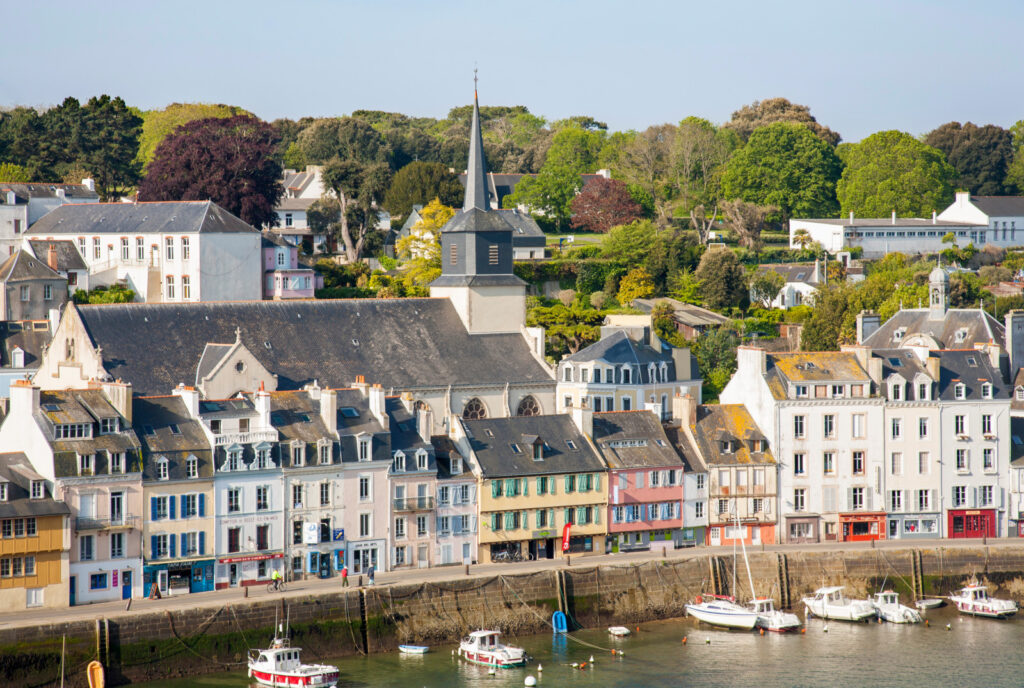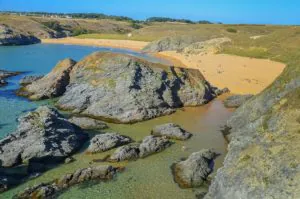
Belle-Île is a timeless beauty. Its charm has captivated famous personalities over the years, and even today, the island ranks among Brittany’s top attractions. Whether for a full island getaway or just a day trip, Belle-Île will delight beach lovers, hiking enthusiasts, and culture seekers alike.
Arrival in Le Palais
The largest island in Brittany lies about 14 kilometers off the mainland in the Bay of Morbihan. Reached by ferry from Quiberon, the first point of contact with Belle-Île is Le Palais, the town on the northern coast closest to the mainland.
Upon arrival in Le Palais, the lighthouses and seaside fortress immediately catch the eye. Originally built as a castle and later used as a prison, mainly for political prisoners, the complex, designed by the famous architect Vauban, now houses a museum. From the massive castle walls, you have a splendid view of the water and the quaint old town of Le Palais.
However, most visitors don’t linger too long in town. For many, Le Palais is the starting point for exploring the 87-square-kilometer island. Besides your own car, bikes, rental vehicles, or the island’s bus network are good options for getting around.
Sights on Belle-Île
Of course, Belle-Île-en-Mer has an inland area. But the grassy interior is far less spectacular than the coastline. Along 80 kilometers of Atlantic shoreline, rocky cliffs alternate with coves and fine sandy beaches.
Several writers, including Proust, Dumas, Flaubert, and Gide, returned from Belle-Île deeply impressed, especially by its stunning coastline. The artist Henri Matisse also visited the island, while Claude Monet immortalized the “Aiguilles de Port Coton” (Needles of Port Coton) in one of his paintings, a particularly striking part of the southern coast.
The “Needles” near Port Coton rise from the sea as jagged rock formations, sculpted by wind and waves. Especially during rough seas, they offer a spectacular natural show. One of the best views of the churning sea can be had from the Goulphar lighthouse, located a bit further inland.
In addition to authors and painters, Belle-Île is also known as a place of longing for dancer Sarah Bernhardt. At the end of the 19th century, the world-famous performer had a home built on the Pointe des Poulains, at the northeastern tip of the island. She spent 29 summers on Belle-Île. Today, her castle-like residence houses a museum dedicated to her life and legacy.

Further west, but still at the northern tip, lies the Grotte de l’Apothicairerie. This sea cave was once home to cormorants that built their nests in the coastal cliffs. Its name, the Apothecary’s Cave, comes from the unusual way the nests were arranged, resembling the shelves of an old apothecary. The descent to the cave is possible today but should only be attempted by experienced hikers.
You’ll also need to be in good shape if you plan to hike the full circuit around Belle-Île. A complete loop takes two to three days. There are easier ways to explore the island, but hiking is by far the most enriching.
Towns and Beaches on Belle-Île
Opposite Quiberon and along the southern coast, the beaches tend to be calm and gentle. From Pointe de Taillefer, you can enjoy a beautiful view of the Morbihan coastline.
When the weather is sunny, the shallow turquoise waters around Belle-Île resemble a Caribbean beach. In general, Belle-Île enjoys more sunshine and less rain than other parts of Brittany, such as Finistère.
Fine sandy beaches like Plage de Donnant and Plage des Grands Sables offer ideal conditions for all kinds of water sports: kite surfing, snorkeling, diving, stand-up paddling – you name it.
Like Le Palais, two other Belle-Île settlements are located along the coast. The village of Locmaria in the southwest is known for its traditional church and charming market square. Sauzon, in the northeast, is a picturesque fishing village. Only Bangor, located in the center of the island, cannot claim a coastal location.
The History of the Island
Belle-Île has a long and eventful history. People have lived here since the Stone Age and left their mark. In the 17th century, Louis XIV’s finance minister, Nicolas Fouquet, purchased the island. At one point, Belle-Île was even under British control. As part of the treaty transferring Canada to Britain, the island was returned to France.
Beyond documented history, two menhirs (standing stones) on Belle-Île are shrouded in legend. Near Runelo stand two stones said to be lovers who were turned to stone. Jean and Jeanne of Runelo, a bard and a simple farmer’s daughter, wished to marry. But the island’s druids had other plans and opposed their union. To prevent the wedding, they asked the island’s witches to turn the couple into stone.
Let yourself fall under the spell of Belle-Île too!
Images: Comité Régional du Tourisme de Bretagne | © Remedio Valls, © Fanny Sabatier
